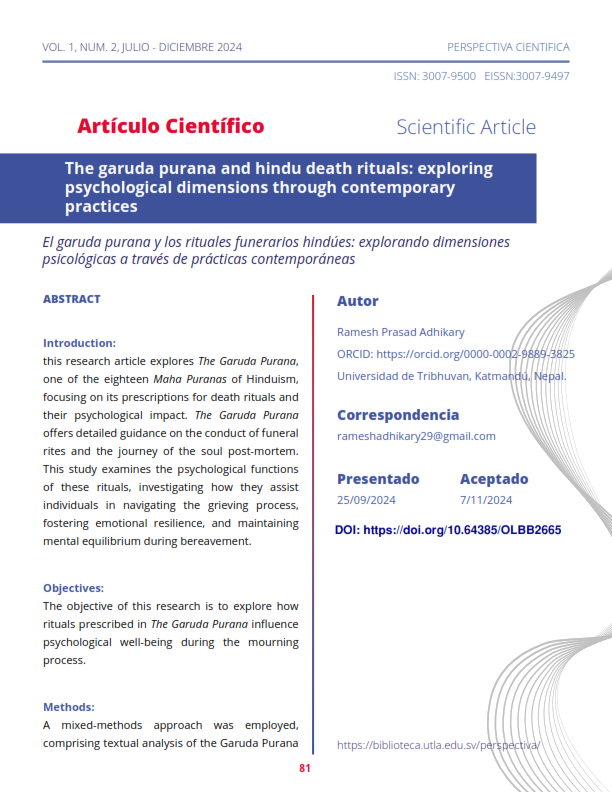The garuda purana and hindu death rituals:
exploring psychological dimensions through contemporary practices
DOI:
https://doi.org/10.64385/OLBB2665Palabras clave:
Death rituals, Hinduism, Physicol, Psychological impact, Emotional resilienceResumen
Introduction: this research article explores The Garuda Purana, one of the 18 Maha Puranas of Hinduism, focusing on its prescriptions for death rituals and their psychological impact. The Garuda Purana offers detailed guidance on the conduct of funeral rites and the journey of the soul post-mortem. This study examines the psychological functions of these rituals, investigating how they assist individuals in navigating the grieving process, fostering emotional resilience, and maintaining mental equilibrium during bereavement. Objectives: The objective of this research is to explore how rituals prescribed in The Garuda Purana influence psychological well-being during the mourning process. Methods: mixed-methods approach was employed, comprising textual analysis of the Garuda Purana and thematic analysis of interviews with Hindu priests and bereaved family members. The textual analysis revealed Purana’s emphasis on rituals for purifying the soul, mitigating sins, and fostering communal support, providing a structured framework for navigating grief. Thematic analysis of interviews underscored the psychological benefits of ritual participation, highlighting themes of solace, control, and communal support among participants. Results: findings indicate that engaging in these rituals offers a sense of purpose and empowerment to the bereaved, aiding in the acceptance of loss and mitigating existential anxieties. The communal nature of these rituals was found to play a crucial role in providing emotional support and solidarity within the grieving community.
Descargas
Referencias
Bonanno, G. A., & Kaltman, S. (2001). The varieties of grief experience. Clinical Psychology Review, 21(5), 705-734.
Fowler, J. D. (1997). Hinduism: Beliefs and Practices. Sussex Academic Press.
Kinsley, D. R. (1987). Hindu Goddesses: Visions of the Divine Feminine in the Hindu Religious Tradition. University of California Press.
Rocher, L. (1986). The Puranas. Otto Harrassowitz Verlag.
Parry, J. (1994). Death in Banaras. Cambridge University Press.
Goyal, S. (2001). The cultural significance of Hindu death rituals. In Death and Afterlife in Indian Religions.Munshiram Manoharlal Publishers.
Bryant, E. F. (2007). Krishna: A Sourcebook. Oxford University Press.
Das, S. (2003). Hinduism and death. In Encyclopedia of Death and Dying. Routledge.
Mukherjee, S. (2001). The concept of sin and karma in Hinduism. Journal of Hindu Studies, 3(2), 45-59.
Corr, C. A., & Doka, K. J. (2001). Anticipatory grief and mourning: Loss of the assumptive world. Routledge.
Stroebe, M. & Schut, H. (1999). The dual process model of coping with bereavement: Rationale and description. Death Studies, 23(3),197-224.
Rocher, L. (1986). The Puranas. Otto Harrassowitz Verlag.
Brockington, J. L. (2003). The Sacred Thread: A Short History of Hinduism. Edinburgh University Press.
Parkes, C. M. (1972). Bereavement: Studies of grief in adult life. Tavistock Publications.
Bonanno, G. A., & Kaltman, S. (2001). The varieties of grief experience. Clinical Psychology Review, 21(5), 705-734.
Goyal, S. (2001). The cultural significance of Hindu death rituals. Death and Afterlife in Indian Religions. Munshiram Manoharlal Publishers.
Bonanno, G. A. (2004). Loss, trauma, and human resilience: Have we underestimated the human capacity to thrive after extremely aversive events? American Psychologist, 59(1), 20-28.
Mani, V. (Trans.). (2009). Garuda Purana. Kashi Press.

Publicado
Número
Sección
Categorías
Licencia

Esta obra está bajo una licencia internacional Creative Commons Atribución-NoComercial 4.0.
Eres libre de:
- Compartir : copiar y redistribuir el material en cualquier medio o formato
- Adaptar : remezclar, transformar y desarrollar el material
- El licenciante no puede revocar estas libertades siempre que usted cumpla con los términos de la licencia.
En los siguientes términos:
- Atribución : debe otorgar el crédito correspondiente , proporcionar un enlace a la licencia e indicar si se realizaron cambios . Puede hacerlo de cualquier manera razonable, pero no de ninguna manera que sugiera que el licenciante lo respalda a usted o a su uso.
- No comercial : no puede utilizar el material con fines comerciales .
- ShareAlike — Si remezclas, transformas o construyes sobre el material, debes distribuir tus contribuciones bajo la misma licencia que el original.
- Sin restricciones adicionales : no puede aplicar términos legales ni medidas tecnológicas que restrinjan legalmente a otros hacer algo que la licencia permite.
Avisos:
No es necesario cumplir con la licencia para los elementos del material que sean de dominio público o cuyo uso esté permitido por una excepción o limitación aplicable .
No se ofrecen garantías. Es posible que la licencia no le otorgue todos los permisos necesarios para el uso previsto. Por ejemplo, otros derechos, como los de publicidad, privacidad o derechos morales, pueden limitar el modo en que utiliza el material.


























